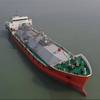The U.S. Navy awarded Northrop Grumman Corporation an additional contract modification for further work on the LHA 6 amphibious assault
ship. The contract award will be utilized for special study work and
for additional long-lead time material procurement to support ship
construction.
This $20 million contract modification provides for special
studies and analyses on LHA 6's systems, including hull, mission, total
ship survivability, warfare, machinery and aviation. Engineering,
planning and technical support work will be accomplished as
requirements leading to the detail design development. Additional
funding will be utilized for the long-lead material. The detail design
and construction contract award is expected in 2007.
The LHA 6 will replace the LHA 1 class of amphibious assault
ships, and will have the flexibility to operate in the traditional role
as the flagship for an expeditionary strike group (ESG) as well as
potentially playing a key role in the maritime prepositioning force
future (MPF(F)). Northrop Grumman has built five LHAs, as well as seven
USS Wasp (LHD 1)-class ships. The company's Pascagoula shipyard is
currently building an eighth LHD, Makin Island.
LHA 6 will be a variant of the gas-turbine powered LHD 8. The
one key difference is that the LHA 6 will be built without a well deck,
which will optimize the ship for aviation operations. Changes from the
LHD design include an extended hangar deck with two overhead cranes,
extended high-bay areas for aircraft maintenance, a reconfigurable
command-and-control complex, a relocated and smaller hospital facility,
additional aviation fuel capacity, and numerous aviation-support
spaces.
These changes equate to a ship that is much more capable of
providing the nation with its only sustainable, forcible entry
capability. LHA 6 will facilitate forward presence and power projection
in support of expeditionary operational concepts as an integral part of
joint, interagency and multinational maritime forces. It will embark,
support and operate for sustained periods with landing force elements,
including the STOVL F-35 B Joint Strike Fighter and the tilt-rotor V-22
Osprey aircraft. It will also embark various naval amphibious tactical
and administrative organizations for command and control.
Subscribe for
Maritime Reporter E-News
Maritime Reporter E-News is the maritime industry's largest circulation and most authoritative ENews Service, delivered to your Email five times per week










